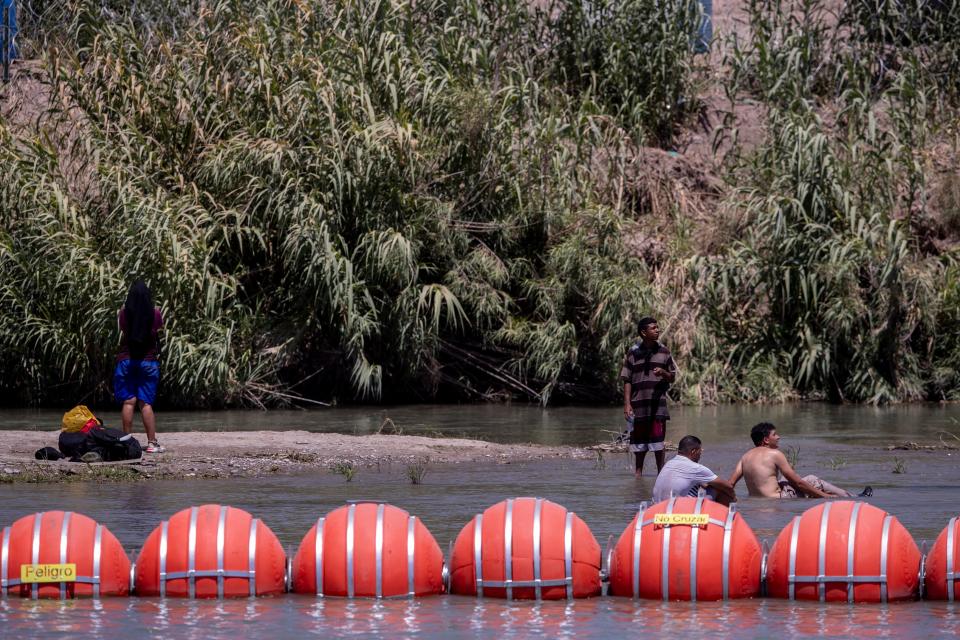'Navigability' of the Rio Grande? 5th Circuit Court takes up Texas border buoys case
- Oops!Something went wrong.Please try again later.
The full 5th U.S. Circuit Court of Appeals heard conflicting accounts Wednesday on whether the section of the Rio Grande where the state of Texas installed a 1,000-foot barrier of floating buoys to deter unlawful crossings by migrants is "navigable" and therefore subject to federal authority.
In a hearing before the New Orleans-based appellate court, Lanora Pettit, deputy solicitor general for the Texas attorney general's office, told the 27 judges that the narrow, shallow stretch of the international river near Eagle Pass is hardly fit to carry commercial vessels and has never been used to do so.
"Too many rocks and not enough water," Pettit said during the hourlong hearing, which was carried by audio-only livestream.
Michael Gray, who is representing the federal government in the lawsuit filed against Texas and Gov. Greg Abbott in response to the buoys' placement, said Pettit's definition of navigability is too limited.

Whether commercial boats can traverse the river upstream and downstream is not the issue, Gray said. The question is whether vessels can get from one shore to the other. And since U.S. Border Patrol boats are constantly on the Rio Grande near where the buoys have been anchored since July 2023 because of Abbott's claims that the water barrier is needed to defend the state from an "invasion" of migrants crossing from Mexico, Gray said that proves the river is navigable. So does the commercial rafting and canoeing business that operates in that area of the Rio Grande, he added.
"These all show that there's sufficient water in the river for similar types of commerce," Gray said.
The federal government's lawsuit hinges on a section in the U.S. Rivers and Harbors Act of 1899 that says the U.S. Army Corps of Engineers must sign off on any plans to place a wharf, pier, boom breakwater, bulkhead, jetty or other structures in navigable waters.
The 5th Circuit is considering whether an order handed down last year by Senior U.S. Judge David Allan Ezra of the Western District of Texas requiring the buoys to be moved to the Texas shoreline should stand pending a trial on the merits of the lawsuit.
A three-judge panel of the 5th Circuit in December upheld Ezra's ruling but the barriers have been allowed to remain in place pending a ruling by the full court. Chief Judge Priscilla Richman gave no indication Wednesday on when the court would rule on the matter.
More: Hundreds of migrants breach razor wire barrier in El Paso as Texas SB 4 remains in limbo
Pettit argued that Gray's definition of navigability would effectively take rivers and streams throughout the country from the traditional authority of the states and place them under federal jurisdiction. One of the judges, whose voice could not be identified from the audio stream, made what he acknowledged was an "absurd" but pointed comparison to "friends just ferrying in a small rowboat Girl Scout cookies" to sell would render any tiny stream "navigable."
Gray countered that the Rio Grande, as a river connecting Texas to Mexico, cannot be likened to a small channel contained within the boundaries of a single state.
The buoys, which came with a price tag estimated at $1 million, have emerged as more of a symbolic gesture than an actual deterrent to unlawful immigration. Because the barrier is less than one-quarter mile long and sits in normally shallow waters, news organizations have captured still images and video of migrants simply bypassing the chain to reach the Texas side of the river.
Still, they are part of Abbott's $11 billion border initiative called "Operation Lone Star," which was launched just weeks after President Joe Biden moved into the White House and began rolling back many of the hard-line immigration policies former President Donald Trump ordered, namely Title 42 expulsions — a COVID-19 era measure that allowed the country to quickly expel migrants over public health concerns.
The buoys are not the only legal matter pending before the 5th Circuit involving the federal government challenging Texas' actions to take an unprecedented role in immigration enforcement. Last month, a three-judge panel of the court put on hold a Texas law that would have authorized state and local law enforcement officers to arrest and deport people suspected of being in the United States without legal authorization.
The merits of the federal lawsuit filed in response to the state law enacted last year, known as Senate Bill 4, have not yet been fully litigated.
This article originally appeared on Austin American-Statesman: Lawyers spar over whether Texas buoys impede navigation on Rio Grande

